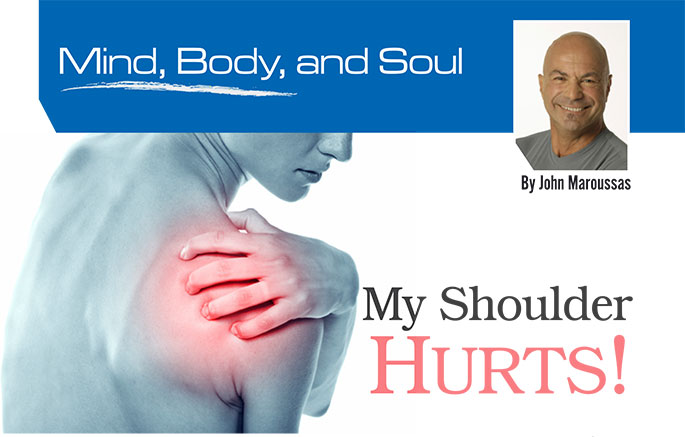Most of the joints in our bodies have a limited range of motion, and the connection with the adjacent bone protects them from injury. The shoulder joint is one of the few exceptions: it is a ball-and-socket joint which allows movement in almost any direction. Unlike the other major joints it is kept in proper position only by the surrounding muscles and tendons, the deltoid and the four small muscles that make up the rotator cuff. The price of this flexibility is that shoulder injuries can happen more easily.
This can be something obvious like an awkward lift in the gym, or something apparently trivial, that hits one of these muscles at an angle it isn’t prepared to accommodate, like an infirm person leaning heavily on your arm. Overhead activity, like painting the walls at home, to the  point where it causes pain is also a possible cause of injury.
point where it causes pain is also a possible cause of injury.
So tissues are damaged, and the inflammatory response will cause swelling and pain. The classic RICE treatment — Rest, Ice, Compression and Elevation — is still the best first aid for such an injury.
If the injury affects only the muscle (in the absence of serious tearing, for which you should seek medical attention) the chances are that it will clear up fairly quickly. Often though such injuries cause damage to the tendons – they attach muscles to bones – and because tendons do not have such a good blood supply as muscles, it takes longer for healing to occur. In this case a two-week course of a medication like Advil will usually reduce the inflammation and eliminate the pain.
If you have strained any of the muscles of the rotator cuff, you will feel pain around the shoulder, most frequently on the outside part. Sometimes pain will run down the arm, even as far as the elbow. Less commonly people experience pain in the front or back of the shoulder itself. If pain is present during activities like getting dressed, performing household chores, or  lifting light objects, or if it causes sleeping difficulties, consult a healthcare professional.
lifting light objects, or if it causes sleeping difficulties, consult a healthcare professional.
If your symptoms have only been present for a few days, they will often clear up on their own. After several weeks of pain however, anti-inflammatory medication such as Advil, physical therapy, and above all rest may be needed to allow for recovery.
After the pain goes away, you can GRADUALLY return to regular activities. In the recovery phase, there are some exercises which will strengthen the entire group of shoulder muscles. These exercises are also useful to prevent injury, and can be used as a warm-up before strenuous exercise.
- In a standing position, with your upper arm close to your side, move a light dumbbell through 180 degrees starting with your forearm horizontal across your stomach and slowly moving your forearm outwards till it is pointing outwards at your side. Reverse this motion, bringing the dumbbell back across your body. Repeat.
- Now hold your upper arm horizontally at your side and with your elbow bent at 90 degress, raise the dumbbell until your forearm is vertical.
- Hold the dumbbell out in front of you with your whole arm horizontal at shoulder height and your palm facing outwards. Keeping your arm as straight as possible, move your arm without bending the elbow until your arm is straight down, with the palm still facing outwards.
- Finally, lie on your side on an exercise mat. Your lower arm should be bent to support your head. The other upper arm should stay close to your upper side while you rotate your forearm from vertical to horizontal and back again.














